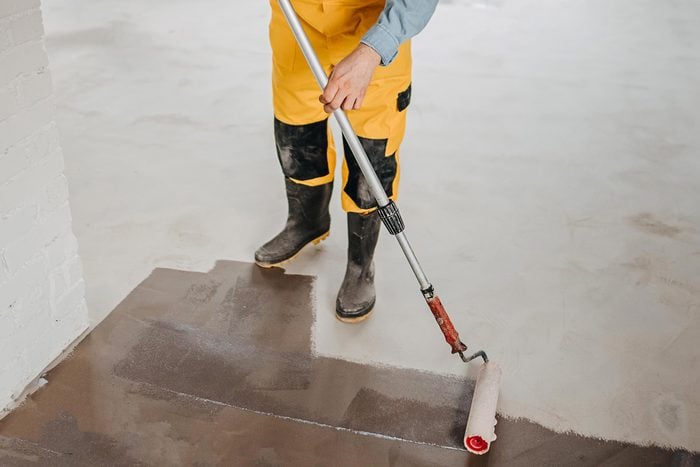7 Reasons You Should Consider Epoxy Basement Flooring
Updated: Feb. 06, 2023

Epoxy is waterproof, durable, attractive and DIY friendly. These factors make epoxy an exceptional basement flooring choice.
Epoxy floors always make me think of hockey. Many Canadian kids grow up with an obsession for the sport. Before they’re old enough to put on skates, they learn the basics of stick-handling and shooting by playing with friends in the basement.
For the pick-up team in my childhood neighborhood, no floor was better than the epoxy floor in the basement of the team captain’s house — which is probably why he was the captain!
That floor was super smooth without the slipperiness of polished concrete or laminate, as close as you could get to real ice. It provided the traction we needed to play safely. And because epoxy is pretty much indestructible, play was never interrupted by holes, cracks or crumbling concrete. The cheery cream-colored surface added to the fun.
An epoxy basement floor provides plenty for adults to like, too, whether the basement serves as utility, recreation or living space. It’s one of the easiest types of floors to install, solving many of the humidity problems commonly found in basements. And it lasts.
If you’re considering upgrading your basement flooring, here are seven reasons you should consider epoxy.
On This Page
Locks Out Moisture
Basements are inherently damp because they’re built into the ground close to the water table, and much of the moisture comes up through the floor. Nothing blocks that moisture better than epoxy.
Unlike a waterproofing sealer, which makes concrete more resistant to seepage, epoxy forms a hard plastic film water can’t penetrate.
Waterproofing the floor with an epoxy coating won’t completely solve moisture issues, because water can enter through the walls and around the windows. It’s a good start, though. Once you eliminate issues with the floor, addressing other sources of moisture become more straightforward.
Highly Durable
In a high-traffic industrial setting like a factory, an epoxy floor might last two or three years. But in a residential basement, the lifespan expands to 10 to 20 years. With proper maintenance, it can easily last longer.
A common coating for garage floors, epoxy resists impacts and won’t chip or crack. It also resists scratching, so you can drag your furniture and appliances across the floor without a second thought. When the floor does need a refresher, a top coat of fresh epoxy usually does the job.
Greener Than You Think
Two-part epoxy consists of a resin and a hardener. In liquid form, some products off-gas seriously noxious fumes. However, the hardener acts as a catalyst to turn the molecules in the resin (monomers) into long chains (polymers) that the California Department of Health Services characterizes as “almost non-toxic.”
You’ll need to wear a respirator to avoid inhaling fumes. You should also turn off the home’s HVAC system and open windows when applying the product. But once the epoxy coating cures, it’s safe for the entire family.
Epoxy is eco-friendly in another way. Unlike vinyl tiles or laminates, it won’t clog the landfill because you’ll never have to remove it and throw it away.
Easy to Clean
Epoxy is one of the easiest floor coverings to keep clean. It needs occasional sweeping, and most scuffs and skid marks come off with a mixture of mild soap (like Simple Green) and water. The hard plastic coating resists chemical spills and seldom stains.
Mold Resistant
Because basements tend to be cool and poorly ventilated, condensation often collects and promotes mold growth. But mold spores need to take root before they can grow. Because epoxy is non-porous, it provides no opportunity for that. An epoxy floor is mold-free!
However, mold can grow under rugs. If you put down any rugs, take them outside and dry them in the sun occasionally.
Looks Great
A smooth, shiny epoxy finish definitely brightens a dark basement. Products come in a wide range of hues, making color-matching easy. If you want to be creative, paint patterns onto the floor with two or three colors of epoxy.
Installation is DIY-able
It takes more effort to apply epoxy than simply rolling the paint onto the floor, but it isn’t necessarily work that requires a pro.
You’ll have to patch large cracks and holes in the floor with hydraulic cement and smaller ones with caulk. And if the concrete is smooth, etch it with a floor buffer and a diamond-grit sanding screen so the epoxy can adhere properly. Once that’s done, you can paint.
A two-part epoxy product isn’t required. Water-based epoxy floor coatings can go on right out of the can, without mixing.
